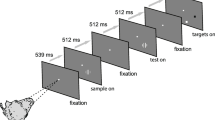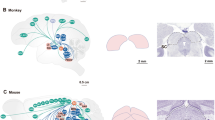Summary
-
1.
The central mesencephalic reticular formation (cMRF) was electrically stimulated in the alert monkey. Saccadic eye movements were induced to the contralateral side in the horizontal plane at latencies of 18–35 ms. Smooth or slow eye deviations were not produced by cMRF stimulation. If the stimulus was given during slow phases of nystagmus, rapid eye movements were elicited, and the velocity of the slow phases was not affected. The function of cMRF neurons and/or of pathways that lie within it appear primarily related to generation of rapid eye movements in the horizontal plane.
-
2.
The amplitude of induced saccadic eye movements depended solely on the region of cMRF that was activated. When the stimulation frequency was lower, the latency was longer, but the size and characteristics of the induced movement were the same. The product of latency and stimulus frequency was approximately constant, suggesting that saccades had been triggered after a fixed number of pulses had been given.
-
3.
Stimulation of cMRF at frequencies that were too low to elicit rapid eye movements had a tonic effect on saccade generation. When the animal was having optokinetic nystagmus (OKN), stimulation modulated beat frequency according to the direction of the nystagmus: contralateral quick phases were facilitated and ipsilateral quick phases were suppressed. The frequencies of stimulation necessary to suppress ipsilateral quick phases increased as slow phase eye velocity increased. This demonstrates that both cMRF activity and slow phase velocity affect quick phase triggering. When the cMRF on both sides were simultaneously stimulated, the eyes were fixed in place, and no further rapid movements occurred until the stimulus had ended. Thus, activity in pathways and/or cells in cMRF is not only able to trigger saccades, but can also change the excitability of saccade generating mechanisms and promote fixation by suppressing eye movements.
-
4.
Two types of rapid eye movements were elicited from cMRF. From dorsal portions of cMRF saccades were induced whose size was relatively constant and not dependent on the initial position of the eyes in the orbit. The size of saccades increased from small to large as the stimulating electrode was advanced through cMRF from dorsal to ventral. This suggests that the tecto-bulbo-spinal efferents coursing through cMRF and/or cMRF neurons related to this input, are organized in a topographic fashion, with cells and fibers related to eye movements of increasing size being layered one beneath another. In ventral portions of cMRF, saccades were elicited whose size was dependent on eye position; the induced movement were larger when the eyes were on the ipsilateral side and smaller when the eyes were on the contralateral side. It is likely that cMRF-induced movements are utilized in shifting gaze. The variable amplitude movements might be employed in gaze shifts that involve head movement.
-
5.
The results suggest that cMRF neurons as well as tectal output pathways lying in cMRF, have activity that can trigger horizontal saccades. Temporal aspects of the bursts determine when the saccade will occur. The region of cMRF that is active determines the size and type of the evoked saccade and is topographically organized in accordance with the output from the superior colliculus coursing through it. Activity in this region can also inhibit saccade generation.
Similar content being viewed by others
References
Anderson ME, Yoshida M, Wilson VJ (1971) Influence of superior colliculus on cat neck motoneurons. J Neurophysiol 34: 898–907
Astruc J (1971) Corticofugal connections of Area 8 (frontal eye fields) in Macaca mulatta. Brain Res 33: 241–256
Bahill AT, Clark MR, Stark L (1975) The main sequence, a tool for studying human eye movements. Math Biosci 24: 191–204
Barnes GR, Benson AJ (1973) A model for the prediction of the nystagmic response to angular and linear acceleration stimuli. AGARD-CP-128. Conference on the Use of Nystagmography in Aviation Medicine, May 1973, A23-1 to A23-13
Bender MB, Shanzer S (1964) Oculomotor pathways defined by electric stimulation and lesion in the brainstem of monkeys. In: Bender MB (ed) The oculomotor system. Harper & Row, New York, pp 81–140
Buettner U, Buettner-Ennever JA, Henn V (1977) Vertical eye movement related activity in the rostral mesencephalic reticular formation of the alert monkey. Brain Res 130: 239–252
Buettner-Ennever J, Buettner U (1978) A cell group associated with vertical eye movements in the rostral mesencephalic reticular formation of the monkey. Brain Res 151: 31–47
Chun KS, Robinson DA (1978) A model of quick phase generation in the vestibuloocular reflex. Biol Cybern 28: 209–221
Cohen B, Henn V (1972) The origin of quick phases of nystagmus in the horizontal plane. Bibl Ophthal 82: 36–55
Cohen B, Komatsuzaki A (1972) Eye movements induced by stimulation of the pontine reticular formation: evidence for integration in oculomotor pathways. Exp Neurol 36: 101–117
Cohen B, Buettner-Ennever JA, Waitzman DM, Bender MB (1981) Anatomical connections of a portion of the dorsolateral mesencephalic reticular formation of the monkey associated with horizontal saccadic eye movements. Soc Neurosci Abstr 7: 132
Cohen B, Matsuo V, Raphan T, Waitzman D, Fradin J (1982) Horizontal saccades induced by stimulation of the mesencephalic reticular formation. In: Roucoux A, Crommelinck M (eds) Physiological and pathological aspects of eye movements. Dr. W Junk Publishers, The Hague, pp 325–335
Cohen B, Buettner-Ennever JA (1984) Projections from the superior colliculus to a region of the central mesencephalic reticular formation (cMRF) associated with horizontal saccadic eye movements. Exp Brain Res (in press)
Edwards SB (1975) Autoradiographic studies of the midbrain reticular formation: descending projections of nucleus cuneiformis. J Comp Neurol 161: 341–358
Edwards SB (1980) The deep cell layers of the superior colliculus: their reticular characteristics and structural organization. In: Hobson JA, Brazier MAB (eds) The reticular formation revisited. Raven Press, New York, pp 193–209
Edwards SB, deOlmos JS (1976) Autoradiographic studies of the midbrain reticular formation: ascending projections of nucleus cuneiformis. J Comp Neurol 165: 417–432
Goldberg ME, Bushnell MC (1981) Behavioral enhancement of visual responses in monkey cerebral cortex. II. Modulation in frontal eye fields specifically related to saccades. J Neurophysiol 46: 773–787
Grantyn A, Grantyn R (1982) Axonal patterns and sites of termination of cat superior colliculus neurons projecting in the tecto-bulbar-spinal tract. Exp Brain Res 46: 243–250
Guitton D, Crommelinck M, Roucoux A (1980) Stimulation of superior colliculus in the alert cat. I. Eye movements and neck EMG evoked when the head is restrained. Exp Brain Res 39: 63–73
Harting JK (1977) Descending pathways from the superior colliculus: an autoradiographic analysis in the rhesus monkey (Macaca mulatta). J Comp Neurol 173: 583–612
Harting JK, Huerta MF, Frankfurter AH, Strominger NL, Royce GJ (1980) Ascending pathways from the monkey superior colliculus: an autoradiographic analysis. J Comp Neurol 192: 853–882
Hepp K, Henn V (1983) Spatio-temporal recording of rapid eye movement signals in the monkey paramedian pontine reticular formation (PPRF). Exp Brain Res 52: 105–120
Hikosaka D, Igusa Y (1980) Axonal projections of prepositus hypoglossi and reticular neurons in the brainstem of the cat. Exp Brain Res 39: 441–451
Kawamura K, Brodal A, Hoddivik G (1974) The projection of the superior colliculus onto the reticular formation of the brainstem. An experimental study in the cat. Exp Brain Res 19: 1–19
Komatsuzaki A, Harris HE, Alpert J, Cohen B (1969) Horizontal nystagmus of rhesus monkeys. Acta Otolaryng (Stockh) 67: 535–551
Komatsuzaki A, Alpert J, Harris HE, Cohen B (1972) Effect of mesencephalic reticular formation lesions on optokinetic nystagmus. Exp Neurol 34: 522–534
Kuenzle H, Akert K (1977) Efferent connections of cortical area 8 (frontal eye field) in Macaca fascicularis. A reinvestigation using the autoradiographic technique. J Comp Neurol 173: 147–164
Lynch JC, Mountcastle VB, Talbot WH, Yin TCT (1977) Parietal lobe mechanisms for directed visual attention. J Neurophysiol 40: 362–389
Olzewski J, Baxter D (1954) Cytoarchitecture of the human brain stem. Karger, Basel
Prechit N, Schwindt PC, Magharini PC (1974) Tectal influences on rat ocular motoneurons. Brain Res 82: 27–40
Raybourn MS, Keller EL (1977) Colliculo-reticular organization in primate oculomotor system. J Neurophysiol 40: 861–878
Robinson DA, Fuchs AF (1969) Eye movements evoked by stimulation of frontal eye fields. J Neurophysiol 32: 637–648
Robinson DA (1972) Eye movements evoked by collicular stimulation in the alert monkey. Vision Res 12: 1795–1808
Roucoux A, Guitton D, Crommelinck M (1980) Stimulation of the superior colliculus in the alert cat. II. Eye and head movements evoked when the hed is unrestrained. Exp Brain Res 39: 75–85
Schiller PH, Stryker M (1972) Single unit recording and stimulation in superior colliculus of the alert rhesus monkey. J Neurophysiol 35: 915–924
Schlag-Rey M, Schlag J (1977) Visual and presynaptic neuronal activity in the thalamic internal medullary lamina of cat: a study of targeting. J Neurophysiol 40: 156–173
Shantha TR, Manocha SL, Bourne GL (1968) A stereotaxic atlas of the java monkey brain. The Williams & Wilkins Company, Baltimore, Maryland
Snider R, Lee JC (1961) A stereotaxic atlas of the monkey brain (Macaca mulatta). University of Chicago Press, Chicago
Sparks DL, Mays LE (1980) Movement fields of saccade-related burst neurons in the monkey superior colliculus. Brain Res 190: 39–50
Szentágothai J (1943) Die zentrale Innervation der Augenbewegungen. Arch Psychiat Nervenkr 116: 721–760
Waitzman DM, Cohen B (1979) Unit activity in the mesencephalic reticular formation (MRF) associated with saccades and positions of fixation during a visual attention task. Soc Neurosci Abstr 5: 389
Weber J, Harting JK (1980) The efferent projections of the pretectal complex: an autoradiographic and horseradish peroxidase analysis. Brain Res 194: 1–28
Winters WD, Kado RT, Adey WR (1969) A stereotaxic brain atlas for Macaca nemestrina. University of California Press, Berkeley
Wurtz RH, Goldberg ME (1972a) Activity of superior colliculus in behaving monkey. III. Cells discharging before eye movements. J Neurophysiol 35: 575–586
Wurtz RH, Goldberg ME (1972b) Activity of superior colliculus in behaving monkey. IV. Effects of lesions on eye movements. J Neurophysiol 35: 587–596
Wurtz R, Albano JE (1980) Visual-motor function of the primate superior colliculus. Ann Rev Neurosci 3: 189–226
Author information
Authors and Affiliations
Additional information
Supported by NIH research grant EY 02296, Core Center grant EY 01867 and a grant from the Young Men's Philanthropic League. Victor Matsuo was supported by fellowship grant EY 07014
Rights and permissions
About this article
Cite this article
Cohen, B., Matsuo, V., Fradin, J. et al. Horizontal saccades induced by stimulation of the central mesencephalic reticular formation. Exp Brain Res 57, 605–616 (1985). https://doi.org/10.1007/BF00237847
Received:
Accepted:
Issue Date:
DOI: https://doi.org/10.1007/BF00237847




